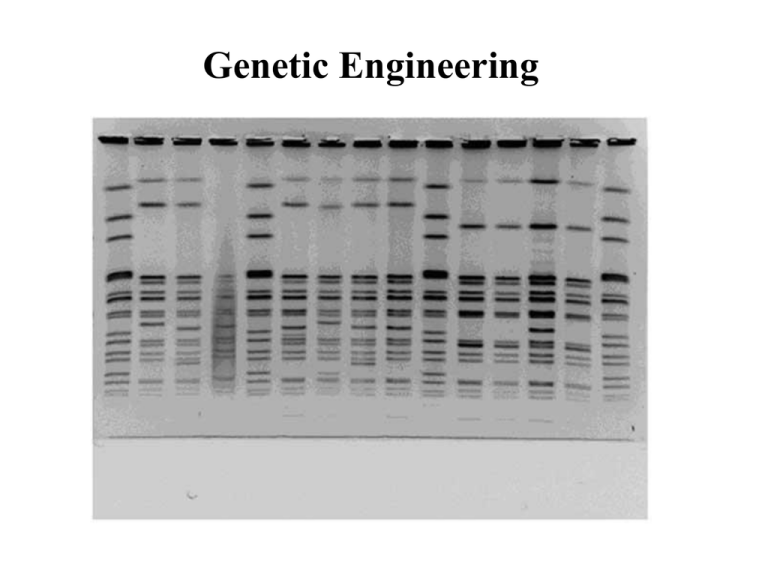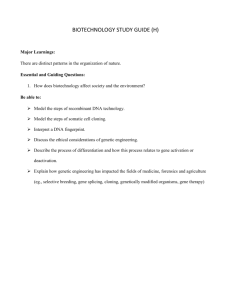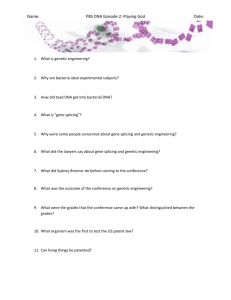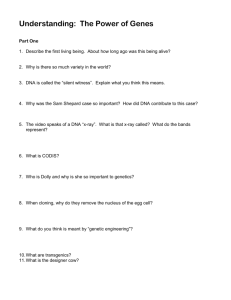Genetic Engineering II
advertisement

Genetic Engineering Polymerase Chain Reaction (PCR) Fig. 16.3 in text • a technique for quickly cloning a particular piece of DNA in the test tube (rather than in living cells like E. coli). • Very useful if only have small quantities such as blood or semen. • Use temperature changes to separate the DNA strand, add primers, polymerase and ta-dah... new strand is made. Gel Electrophoresis and DNA Profiling. Fig 16.2 in text • Method using electricity to separate fragments of DNA – fragments are made by using restriction enzymes • Large segments of DNA (negatively charged) can’t move through gel very far while small ones can. • In agarose gels, fragments of DNA from about 200 to 50,000 bp can be separated • The results from electrophoresis can be used for DNA profiling/fingerprinting – using the patterns of bands of DNA to identify and compare individuals. – Useful for identifying rapists, criminals, determine paternity, determine relatives... Genetic Screening • The testing of an individual for the presence or absence of a gene • Advantages – fewer children with genetic diseases are born (a couple doesn’t reproduce or only selects “good” embryos for implantation) – confirmation of animal pedigrees – if genetic diseases can be found early enough, treatments can be given to prevent all or some of the symptoms of the disease • Disadvantages – frequency of abortion may increase – harmful psychological effects – creation of a genetic underclass (refused jobs, insurance, spouse...) Genetically Modified Organisms • organisms that have had genes from a different organism transferred to them • examples – crops resistant to herbicides (but the weeds are not) – insulin gene from humans is put in the plasmid of E. coli which then makes insulin – a bacterium gene that codes for a protein called Bt toxin that kills moths that bore through corn is transferred to the DNA of corn • Benefits – less pest damage – less land needed for crops – less use of insecticides • Harmful effects – humans/animals my be harmed by toxin – other non-corn eating insects could be killed by pollen from the corn – cross-pollination could spread the toxic gene to some wild corn that would then have an advantage over other natural species Gene Therapy • the treatment of diseases by altering the defective genotype of the organism • example: SCID (severe combined immune deficiency) – screening before birth can show SCID – the enzyme ADA that is necessary to make healthy lymphocytes is not made • lymphocytes, a type of white blood cell, are made from blood forming precursors, or "stem," cells in the bone marrow – the allele that codes for ADA is obtained and the gene is inserted into a retrovirus – the retroviruses insert the gene into the stem cells’ chromosomes – new stem cells containing working ADA gene are injected into the person Clones • a group of genetically identical organisms or cells artificially derived from a single parent cell • ex) Dolly – cells were taken from a donor sheep and the nucleus removed – eggs from another sheep were taken and the nuclei were removed – donor cells and nuclei were fused together using electricity and then developed into embryos that were implanted into a surrogate mother – a lamb was born (Dolly) that was genetically identical to the donor sheep • ethical issues in humans – Pros • happens naturally with twins • infertile couples might have better chance of success with cloning of embryos – Cons • psychological/identity problems for groups of genetically identical people • cells used in cloning have already begun to age and therefore cloned humans may age faster • lead to selection of a super-race of those fit to be cloned








